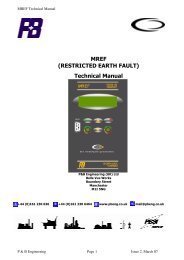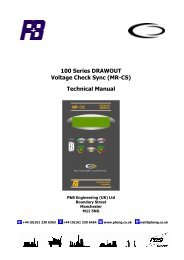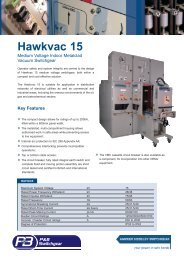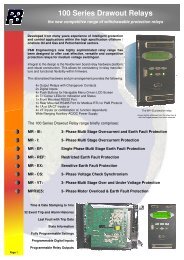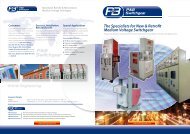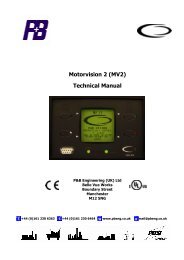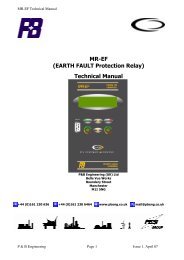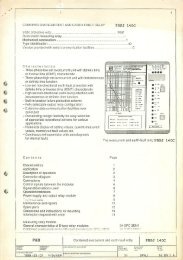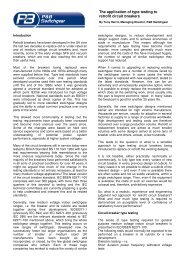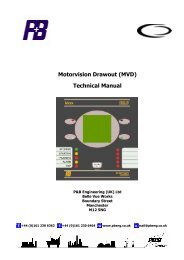(µMOTOR) Technical Manual - PBSI Group Ltd
(µMOTOR) Technical Manual - PBSI Group Ltd
(µMOTOR) Technical Manual - PBSI Group Ltd
Create successful ePaper yourself
Turn your PDF publications into a flip-book with our unique Google optimized e-Paper software.
mMOTOR TECHNICAL MANUAL<br />
16.1.9. Overcurrent.<br />
The MVP may be configured to trip, alarm and/or indicate as a result of an overcurrent<br />
condition, typically caused by a phase or earth fault, mechanical jam or other heavily<br />
loaded motor condition.<br />
Overcurrent protection is usually used to ensure faults are cleared more quickly than that<br />
provided by the Thermal overload protection.<br />
Overcurrent protection is disabled during STARTING and when in TEST MODE.<br />
Trip Level.<br />
The overcurrent pickup is set as a percentage of the Full Load Current (FLC). If the<br />
current rises and remains above the threshold level action is taken after the trip time has<br />
elapsed.<br />
Trip Time.<br />
The trip time is set to determine how long an overcurrent condition can persist before the<br />
configured action is taken.<br />
16.1.10. Earth Fault.<br />
The MVP may be configured to trip, alarm and/or indicate as a result of an overcurrent<br />
condition. Earth Fault measurement can be achieved in one of three ways.<br />
a) using a core balance transformer (CBCT)<br />
b) using a residual connection from the three phase CT’s,<br />
or, at request.<br />
c) using an internal residual connection calculated from the measured phases.<br />
Generally it is desired that earth fault protection be instantaneous although in some<br />
applications transient earth fault currents may be seen, and requires a small delay to be<br />
imposed to prevent nuisance tripping. In most cases the earth fault protection feature<br />
should be set to ensure appropriate coordination with other devices.<br />
Depending on the type of system grounding (resistive or solidly earthed) an earth fault<br />
current has the potential to be very large. The user must be aware of the maximum earth<br />
fault current the system can experience when using the Earth Fault protection feature<br />
with a fused contactor. If solidly earthed, the earth fault current may be much higher than<br />
the rated current breaking capability of the contactor. An attempt to break a fault current<br />
in excess of its rating may cause damage to the equipment. In such applications the<br />
user should ensure appropriate coordination between the device and HRC fuses and/or<br />
disable the Short Circuit protection feature.<br />
Circuit breakers are typically rated to break the full fault current.<br />
Trip Level.<br />
The earth fault pickup is set as a percentage of the EF CT Primary. If the current rises<br />
and remains above the threshold level action is taken after the trip time has elapsed.<br />
With a residual connection as in ‘a’ the EF CT Primary should be set to the<br />
same value as the CT Primary.<br />
With a CBCT connection the EF CT Primary should be set to the primary<br />
rating of the CT.<br />
In an internal earth fault connection the EF CT Primary settable option is<br />
removed and the CT rating is used.<br />
P&B Engineering Issue 6 25/04/2005 Page 47



